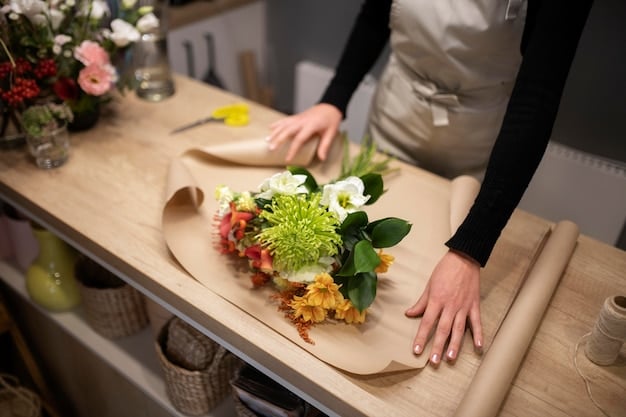Looking to understand how to ship flowers? Well, fresh flowers shipped across the country shouldn’t arrive as wilted disappointments. Yet many business owners face this exact problem – watching profits wither alongside their products during transit.
The flower shipping industry has changed dramatically in 2025. Businesses need effective shipping methods that preserve both flower quality and customer satisfaction.
Market Growth: The flower delivery service market was estimated at USD 7.20 billion in 2023 and is expected to grow at a CAGR of 6.8% from 2024 to 2030.
Your customers don’t just buy flowers – they buy emotions. That anniversary bouquet must arrive vibrant and fresh, not brown and drooping. The wedding centerpieces can’t show up damaged after traveling hundreds of miles. Every damaged shipment doesn’t just mean lost product – it means lost trust. When planning your flower business, especially for events like weddings, understanding the costs involved in flower arrangement and delivery is crucial. Budgeting properly ensures you can maintain quality without sacrificing profit. For insights into effective pricing strategies and cost management in floral services, check out our detailed guide on optimizing your investments in Wedding Arrangement pricing and customer satisfaction.
I’ve spent years in floral logistics, watching businesses struggle with this exact challenge. The most successful flower businesses don’t just ship products – they deliver experiences that arrive intact. The difference between success and failure often comes down to simple, practical techniques that anyone can implement.
Temperature control has become essential as climate patterns grow less predictable. Smart packaging materials have evolved beyond basic boxes. Courier selection matters more than ever with new specialized services entering the market.
This guide contains practical strategies I’ve personally tested with hundreds of floral shipments across varied conditions. You’ll learn exactly how to:
Select packaging that protects without suffocating
Maintain ideal temperatures without expensive equipment
Choose reliable couriers without overpaying In addition to packaging and hydration techniques, selecting dependable shipping partners is crucial. Businesses looking to elevate their delivery service should explore options with specialized floral experience to minimize delays and mishandling. For insights on trusted local options, see our detailed overview of expert Metrobi Baltimore courier services known for their care and timeliness in flower delivery.
Implement cost-effective solutions that preserve quality
The businesses that master these techniques don’t just retain customers – they build reputations that bloom beyond their competition. In addition to mastering floral logistics, understanding how to promote your business effectively is crucial. Many florists have transformed their operations by leveraging successful promotional tactics. To dive deeper, explore this insightful article on transformative marketing strategies that have redefined the industry.
Boost customer satisfaction with just a few clicks
Most-Loved Features:
- On-demand drivers
- Real-time GPS tracking
- Delivery confirmation photos
- Over 50% of customers report a smoother delivery experience
Best Practices for Flower Packaging
Pack flowers in sturdy, waterproof boxes with proper cushioning material to prevent damage
Keep flowers hydrated with floral tubes and moist paper towels
Label packages clearly with “Fragile” and “Perishable” to ensure proper handling, adding any special instructions
1. Select the Right Packaging Materials
The foundation of successful flower shipping begins with selecting appropriate packaging materials. Fresh flowers require specific packaging to maintain their beauty and freshness during transit. The right materials protect flowers from physical damage, temperature changes, and dehydration.
For outer packaging, choose corrugated cardboard boxes specifically designed for flower shipping. These boxes offer superior strength compared to standard shipping boxes and can withstand the rigors of transportation. Look for double-walled boxes for extra protection, especially when shipping to distant locations. These boxes should be new rather than reused to ensure maximum structural integrity and cleanliness.
For inner packaging, select materials that provide cushioning while allowing air circulation. Tissue paper works well for wrapping individual blooms, while kraft paper creates good padding around the entire arrangement. Avoid using plastic bubble wrap directly on flowers as it can trap heat and cause condensation. Instead, use it as an outer layer of protection between the flowers and the box walls. This cushioning material is vital.
Specialized Flower Packaging Options
For premium flowers or high-value shipments, consider specialized packaging solutions. Flower sleeves made from breathable paper protect petals and help maintain proper humidity levels. These sleeves come in various sizes to accommodate different flower types, from long-stemmed roses to bulky hydrangeas.
Water-resistant wrapping paper provides an additional barrier against moisture loss while protecting delicate petals. This type of paper allows some air circulation while preventing complete dehydration. For larger floral arrangements, cell packs (similar to wine bottle dividers) keep flowers separated and prevent them from crushing against each other.
2. Prepare the Flowers for Shipping
Proper preparation before packaging extends flower life significantly during transit. This step is crucial for preventing wilting, petal damage, and stem breakage, especially for potted plants.
Begin by cutting flower stems at a 45-degree angle under running water. This fresh cut maximizes water uptake and extends vase life. Remove any damaged or discolored petals and trim excess foliage, especially leaves that would sit below the water line in hydration tubes. This prevents bacteria growth and keeps the water cleaner.
Hydrate flowers thoroughly before packaging by placing them in clean water with flower food for several hours. This allows flowers to take up water and nutrients that will sustain them during shipping. For roses and other flowers prone to opening quickly, refrigerate them for a couple of hours before packaging to slow their development.
Using Hydration Solutions
Floral tubes are essential for keeping stems hydrated during transit. These plastic containers hold water at the base of each stem, providing continuous moisture. Fill each tube with water and a small amount of flower preservative, then cap it securely around the stem. For flowers with thick stems, use larger tubes; for delicate stems, smaller tubes work better.
For arrangements with multiple stems, consider using floral foam. Soak the foam completely in water mixed with flower preservative before inserting the stems. Wrap the foam base in plastic to prevent leakage while maintaining moisture. Secure the foam block to the bottom of the shipping box to prevent movement.
For extra protection against dehydration, mist flowers lightly with water before packaging and wrap the entire arrangement in slightly damp paper towels. This creates a humidity chamber that helps maintain petal freshness. Be careful not to make the towels too wet, as excess moisture can lead to mold growth.

3. Secure Floral Arrangements Within the Package
Preventing movement inside the shipping box is critical for protecting flowers during transit. Even slight shifting can cause broken stems, crushed petals, or arrangement disruption. Proper use of cushioning material is key here.
Start by wrapping individual flowers or small bunches in tissue paper. For delicate blooms like orchids or lilies, use paper collars around each flower head to prevent petal damage. Secure these wrappings with paper tape rather than plastic tape, which can damage stems and restrict breathing.
For mixed arrangements, place taller, sturdier flowers in the center and more delicate blooms around the edges. Create a protective layer of kraft paper or bubble wrap between the flowers and the box walls. Fill all empty spaces with crumpled paper to eliminate movement, but avoid compressing the flowers.
Specialty Securing Techniques for Different Flower Types
Different flowers require specific securing techniques. For long-stemmed flowers like roses or lilies, create a cardboard grid at the bottom of the box to hold stems in place. Insert each stem through a grid opening and secure the flower tube to keep it upright.
For bulky flowers like sunflowers or dahlias, wrap each bloom individually in tissue paper and secure with a paper collar. Place these heavier flowers at the bottom of the arrangement with lighter blooms on top to prevent crushing.
Orchids and other extremely delicate flowers benefit from plastic support stakes that hold the stem straight without damaging it. Attach the stake to the stem with soft plant ties or cotton string rather than wire or twist ties, which can cut into the stem. For those looking to enhance their floral presentations even further, exploring creative flower arrangement inspirations can make a significant difference. Unique arrangements not only add visual appeal but also elevate the overall customer experience, boosting satisfaction and repeat business.
3. Seal and Label the Package with Special Instructions
Proper sealing and labeling completes the packaging process and helps ensure your flowers receive appropriate handling throughout the shipping journey.
Use strong packing tape to seal all box seams securely. Apply multiple strips across the bottom and top of the box, extending at least a few inches up each side for maximum strength. For added protection against moisture, consider water-resistant tape or apply a layer of plastic wrap around the entire box before taping.
Clear, visible labeling is essential for proper handling. Mark all sides of the box with “FRAGILE” and “PERISHABLE” in large, bold letters. Add “THIS SIDE UP” arrows to ensure the box remains correctly oriented. Include “KEEP AWAY FROM EXTREME TEMPERATURES” to alert handlers about temperature sensitivity. Any special instructions from the customer should also be clearly visible.
Creating Detailed Handling Instructions
Beyond basic warning labels, include detailed handling instructions for couriers. Create a brightly colored label with specific directions such as “Do not stack heavy items on this package” or “Deliver immediately upon arrival.” Some shippers find success with personalizing these instructions: “Live flowers inside – please handle with care!”
For premium or important shipments, consider using custom-printed shipping labels that incorporate all necessary warnings and handling instructions in an eye-catching design. The visual impact helps ensure handlers notice and follow the guidance.
When shipping to businesses, include specific delivery instructions such as “Deliver to receptionist only” or “Do not leave outside.” For residential deliveries, add notes like “OK to leave with neighbor if recipient not home” to prevent delivery delays. Ensure any customer-provided special instructions are included.
4. Choose Special Hydration Methods for Extended Shipping
For flowers traveling long distances or over several days, standard hydration methods may not be sufficient. Special techniques can extend freshness significantly during extended transit times.
Water-soaked cotton balls or small sponges secured around stem ends provide slow-release moisture. Wrap these in plastic wrap to prevent leakage while allowing the stems to absorb water gradually. This method works particularly well for flowers with woody stems like roses or branches.
Hydration sachets containing moisture-retaining gel absorb and gradually release water. Place these sachets near (but not directly touching) flower heads to maintain ambient humidity without causing petal damage. Some commercial sachets also contain mild preservatives that extend bloom life.
Advanced Hydration Technologies
For valuable shipments, consider using professional-grade hydration products. Floral preservative sheets can be cut to size and wrapped around stem ends, providing both moisture and nutrients during transit. These sheets gradually release a balanced solution of water, sugar, and antibacterial agents. Efficient delivery is as crucial as proper packaging. Utilizing a reliable courier ensures flowers arrive on time and in perfect condition. For businesses operating in the Chicago area, leveraging a trusted service like the Metrobi Chicago same-day courier option can significantly enhance delivery speed and customer satisfaction. This specialized courier service is tailored to meet the urgency of perishable goods, making it a strategic choice for florists aiming to maintain their reputation for quality and punctuality.
Modified atmosphere packaging (MAP) technology controls the gas composition around flowers, slowing respiration rates and extending freshness. These specialized bags regulate oxygen, carbon dioxide, and ethylene levels to reduce flower metabolism during shipping.
MAP Vase Life: Modified atmosphere packaging (MAP) can extend the vase life of tulip flowers from 3.3 days (conventional packaging) to 5.7–6.0 days.
MAP Humidity Requirement: The relative humidity of a modified atmosphere package containing cut flowers should be about 90% to about 98% to prevent petal wilting.














